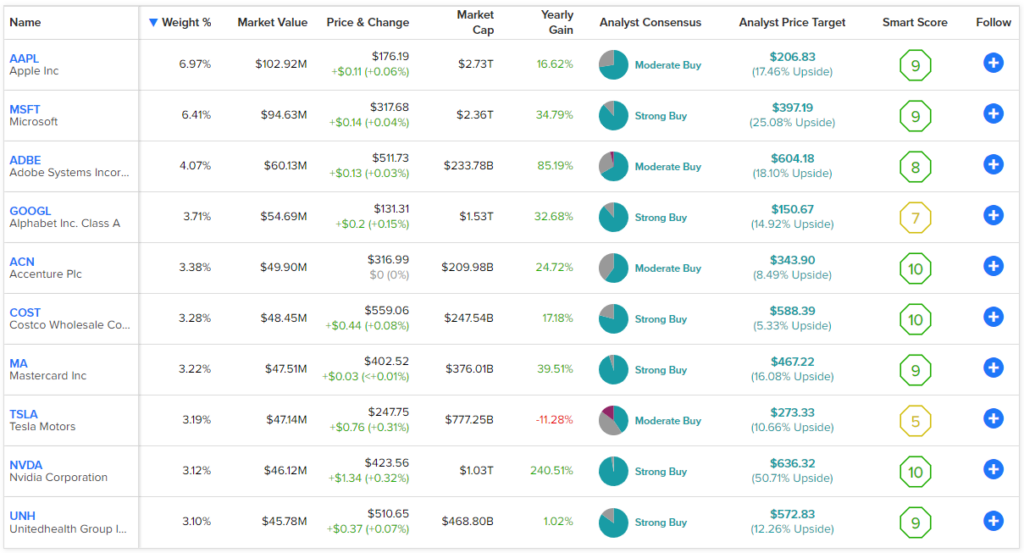The Principal U.S. Mega-Cap ETF (NASDAQ:USMC) believes that bigger is better, as it invests in the largest S&P 500 (SPX) companies. Is this a viable strategy and worth a look from investors? Let’s find out.
What is the USMC ETF’s Strategy?
The Principal U.S. Mega-Cap ETF pursues long-term capital appreciation by investing in U.S. companies “with very large (‘mega’) market capitalizations at the time of purchase,” according to Principal Asset Management. It defines companies with mega market caps as those with market caps in the top 50th percentile of the S&P 500.
Why focus on these large companies? Principal says that investing in mega-cap stocks offers a multitude of advantages. These stocks typically have strong balance sheets, offer ample liquidity, and have well-known brands. Principal also says that these types of stocks typically provide more durability and stability during volatile market environments.
These points make a lot of sense — you don’t achieve a market cap worth hundreds of billions of dollars and hit mega-cap status by being a subpar company, so there’s something to be said for this strategy. But how does it play out in the real world in terms of results? Let’s find out below.
USMC’s Long-Term Performance
It turns out that this mega-cap-focused strategy has been a pretty effective one over time. USMC has returned 20.6% year-to-date in 2023 and 27.1% over the past year. Looking further out, as of the end of August, its three-year annualized return of 11.5% is also impressive, and its five-year annualized return of 12.0% is even better. The fund only launched in 2017, so it doesn’t yet have a 10-year return to measure. However, since its inception in October of 2017, USMC has posted an annualized return of 12.2%.
These returns are actually better than those of the broader market, putting USMC into an enviable position as one of the ETFs that can say it has beaten the market over time. For comparison, the Vanguard S&P 500 ETF (NYSEARCA:VOO), a good representation of the S&P 500, has returned 14.3% year-to-date and 20.1% over the past year.
Also, as of the end of August, VOO returned 10.5% and 11.11% over the past three and five years, respectively, on an annualized basis, meaning that USMC slightly outperformed it over these timeframes as well.
Below, you can take a look at a comparison of USMC and VOO using TipRank’s ETF comparison tool, which enables investors to compare up to 20 ETFs at a time across a wide range of criteria, including expense ratios, assets under management (AUM), and performance over a variety of time horizons.

Reasonable Expense Ratio
In addition to producing market-beating results over the past five years, USMC is also a fairly cost-effective ETF, with a reasonable expense ratio of 0.12%. An investor allocating $10,000 into USMC would pay just $12 in fees during their first year of investing. If the fund returns 5% per year and the expense ratio remains at 0.12%, this investor would pay just $45 in fees after three years, $82 in fees after five years, and $189 after 10 years.
Investing in low-cost ETFs like this allows investors to protect their principal investment and reap more of the rewards from their gains over time.
Additionally, it’s worth noting that USMC is a dividend payer, although its current dividend yield of 1.4% isn’t really significant enough to attract dividend investors.
Mega-Cap Holdings
USMC is not especially diversified, but it isn’t alarmingly concentrated either. The ETF holds 43 positions, and its top 10 holdings combine to make up 40.8% of the fund. Below, you’ll find an overview of USMC’s top 10 holdings using TipRanks’ holdings tool.

You likely won’t be surprised to see Apple (NASDAQ:AAPL) and Microsoft (NASDAQ:MSFT), the world’s two largest companies by market value, at the top of USMC’s list of holdings. USMC gives investors plenty of exposure to the “Magnificent Seven” stocks with these two, plus Alphabet (NASDAQ:GOOGL), Tesla (NASDAQ:TSLA), and Nvidia (NASDAQ:NVDA).
Other members of the Magnificent Seven, like Meta Platforms (NASDAQ:META) and Amazon (NASDAQ:AMZN) appear further down the list of USMC’s holdings. The ETF also adds to this large-cap tech flavor with a position in Adobe (NASDAQ:ADBE).
Beyond big tech, USMC features top 10 positions in other large-cap blue-chip companies like warehouse giant Costco (NASDAQ:COST), consulting firm Accenture (NYSE:ACN), and payment networks Visa (NYSE:V) and Mastercard (NYSE:MA).
One thing that many of these holdings have in common is strong Smart Scores. The Smart Score is a proprietary quantitative stock scoring system created by TipRanks. It gives stocks a score from 1 to 10 based on eight market key factors. A score of 8 or above is equivalent to an Outperform rating. An impressive eight out of USMC’s top 10 holdings feature Outperform-equivalent Smart Scores of 8 or above, and USMC itself features an Outperform-equivalent Smart Score of 8.

The Smart Score is a fan of USMC, and as you’ll see below, so are Wall Street analysts.
Is USMC Stock a Buy, According to Analysts?
Turning to Wall Street, USMC earns a Moderate Buy consensus rating based on 39 Buys, four Holds, and zero Sell ratings assigned in the past three months. The average USMC stock price target of $51.27 implies 18.3% upside potential.

Looking Ahead
In conclusion, USMC ticks a lot of boxes for investors. It has recorded double-digit annualized returns and beaten the broader market over the past five years. Even better, it charges a fee of just 0.12%, which seems very reasonable in light of its strong performance. Also, the fund features a solid portfolio of strong stocks with great Smart Scores, and it enjoys an Outperform-equivalent Smart Score itself. Wall Street analysts are collectively bullish on USMC as well.
The idea of going big by investing in mega-cap companies may indeed be a simple strategy, but it has proven to be an effective one over the past five years, making USMC a solid choice for investors to consider adding to their portfolios.
















